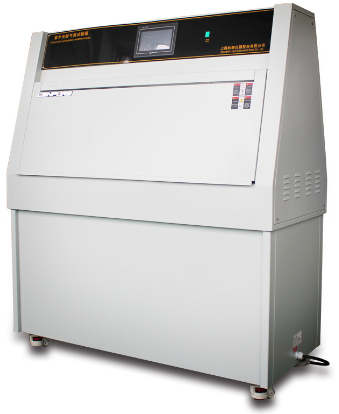Climatic chambers for test standard ASTM G154
This practice is limited to the basic principles for operating a fluorescent UV lamp and water apparatus; on its own, it does not deliver a specific result. It is intended to be used in conjunction with a practice or method that defines specific exposure conditions for an application along with a means to evaluate changes in material properties. This standard needs a climatic chamber-- UV aging test chamber.
This practice is intended to reproduce the weathering effects that occur when materials are exposed to sunlight (either direct or through window glass) and moisture as rain or dew in actual usage. This practice is limited to the procedures for obtaining, measuring, and controlling conditions of exposure.
Test specimens are exposed to fluorescent UV light under controlled environmental conditions. Different types of fluorescent UV lamp sources are described. Specimen preparation and evaluation of the results are covered in ASTM methods or specifications for specific materials. General guidance is given in practice G151 and ISO 4982-1.
The values stated in SI units are to be regarded as standard. No other units of measurement are included in this standard. This standard does not purport to address all of the safety concerns, if any, associated with its use. It is the responsibility of the user of this standard to establish appropriate safety and health practices and determine the applicability of regulatory limitations prior to use. This standard is technically similar to ISO 4892-3 and ISO 16474-3.
Definitions-The determine given in Terminology G113 are applicable to this practice.
Definitions of Terms Specific to This Standard--As used in this practice, the term sunlight is identical to the terms daylight and solar irradiance, global as they are defined in Terminology G113.
Fluorescent Ultraviolet (UV) lamp Apparatus--an apparatus specifically designed for performing artificial accelerated weathering and irradiation tests using fluorescent UV lamps as the light source and including a means to expose the test specimens to moisture and controlled temperature.
Specimens are exposed to repetitive cycles of light and moisture under controlled environmental conditions. Moisture is usually produced by condensation of water vapor onto the test specimen or by spraying the specimens with demineralized/deionized water.
The exposure condition may be varied by selection of:
1. The fluorescent lamp
2. The lamp’s irradiance level
3. The type of moisture exposure
4. The timing of the light, dark, and moisture periods, and the temperature during each exposure condition
The use of this apparatus is intended to induce property changes consistent with the end use conditions, including the effects of the UV portion of sunlight, moisture ang heat. Typically, these exposure would include moisture in the form of condensing humidity. Exposures are not intended to simulate the deterioration caused by localized weather phenomena, such as atmospheric pollution, biological attack, and saltwater exposure.
Alternatively, the exposure may simulate the effects of sunlight through window glass, (Warning--Refer to Practice G151 for full cautionary guidance applicable to all laboratory weathering devices.) This practice provides general procedures for operating fluorescent UV lamp weathering devices that allow for a wide range of exposure conditions. Therefore, no reference shall be made to results from the use of this practice unless accompanied by a report detailing the specific operating conditions in conformance with Section 10.
It is recommended that a similar material of known performance (a control) be exposed simultaneously with the test specimen to provide a standard for comparative purposes. Generally, two controls are recommended: one known to have poor durability and one known to have good durability. It is recommended that at least three replicates of each material evaluated be exposed in each test to allow for statistical evaluation of results.
Comparison of results obtained from specimen exposed in the same model of apparatus should not be made unless reproducibility has been established among devices for the material to be tested. Comparison of results obtained from specimens exposed in different models of apparatus should not be made unless correlation has been established among devices for the material to be tested.
Laboratory Light Source--The light source shall be one or more fluorescent UV lamps. A variety of fluorescent UV lamps can be used for this procedure. Differences in lamp intensity or spectrum may cause significant differences in test results. Do not mix different types of lamps. Mixing different types of lamps in a fluorescent UV apparatus may produce major inconsistencies in the light falling on the samples, unless the apparatus has been specifically designed to ensure a uniform spectral distribution.
A detailed description of the types of lamps used shall be stated in the test report. The particular testing application determines which lamp is used. The apparatus should include an irradiance control system to monitor and control the irradiance levels at the test specimen surface may vary due to the type of lamps, manufacturer of the lamps, age of the lamps, accumulation of dirt or other residue on the lamps, distance to the lamp array, air temperature within the chamber and ambient laboratory temperature.
Fluorescent lamps age with extended use. Follow the apparatus manufacturer’s instruction on the procedure necessary to maintain desired irradiance. Standard Florescent UV Lamps--Fluorescent UV lamps are available with a choice of spectral power distributions that vary significantly. The more common are identified as UVA-340, UVA-351, and UVB-313. These numbers represent the characteristic nominal wavelength (in nm) of peak emission for each of these lamp types. The actual peak emissions are at 343nm, 350nm, and 313nm, respectively.

For more details, please feel free to contact sales@lenpure.com
Please visit www.lenpure.com











